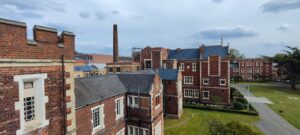Abandoned Hampshire: Morn Hill Camp House | Urbex

Introduction
This WW1 camp house is surrounded by farmland and we walked for a mile and a half to reach it. This was certainly worth it, the trek through farmers fields added to the excitement and suspense as the house emerged from the trees and nature surrounding it. It was clear from first glance that nature had succeeded in claiming back this land, which was even more evident as we explored inside.
See more abandoned places in Hampshire
History of Morn Hill
The history of this house is unclear, which is often the case with residential buildings. However Morn Hill has a rich WWI history and it is believed that the house played a role in this military history. Morn Hill was used as a camping ground for soldiers during WWI. They would travel by train to Chesil Station and then march to Morn Hill or Winnall Down to rest before heading to Southampton Port. Most soldiers only stayed at Morn Hill for a short time. Once their their division was fully assembled they then headed to the front line. Around 2 million men passed through Morn Hill Camp on their way to France. When USA joined the war in 1917 the site was also used by American troops and approximately 800,000 Americans passed through the camp. In 1919, after the end of the war the site was still in use. This time for all Allied troops who were awaiting repatriation. Once this process was completed the camp and all buildings were demolished.
Urban Exploration
The house is half a mile away from the camps on Morn Hill. Presumably it was used as accommodation for those who organised the troops during WWI. The house has been left abandoned for decades and the majority of the first floor has collapsed. Even on the ground floor care had to be taken as the flooring had rotted away and there were piles of rubble everywhere. There were still some beautiful original features to admire though. A couple of wooden doors were in great condition as well as the light switches. A butler-style sink stood in the kitchen along with the fireplace where the open range would have been. Treading cautiously through the house it soon became apparent that we were not the only creatures on the site. In one room towards the back of the house there were animal holes down into the floorboards. It looked like either badgers or foxes had claimed this house as their own.
In another room, the door appeared to be stuck. After kicking it open it turned out that a fresh hare carcass had been the cause of the stuck door. The house seems like it won’t be standing for much longer and nature is reclaiming the land again. Whilst the house doesn’t have any possessions to look through and there isn’t much left to tell the previous owner’s story. I found this exploration insightful all the same and really felt like I was stepping back in time to the Edwardian period. Thank you to the wildlife that let us explore their home undisturbed.
Last Updated on 29 October 2021 by Michael




















